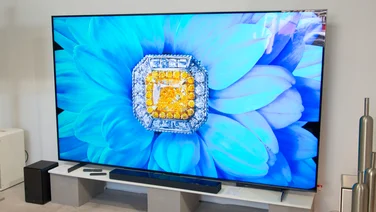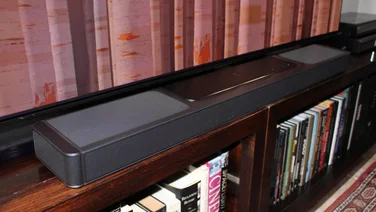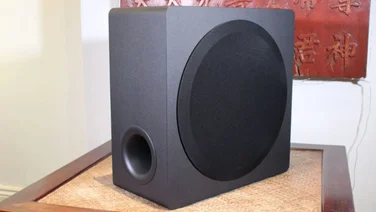To help us provide you with free impartial advice, we may earn a commission if you buy through links on our site. Learn more






- High-class cinematic picture quality
- Flexible about positioning
- Excellent connectivity
- Not so great for gaming
- Streaming dongle is dated
- No Dolby Vision support
Recent trends in projectors have seen them growing smaller, lighter, easier to set up and, frequently, more portable. They’ve become better suited to life in the average lounge, even as a replacement for the main TV. The BenQ W2720i is none of these things.
While it uses an LED light source rather than a traditional lamp, it’s a proper old-school battleship of a projector designed primarily for home cinema use. It incorporates an Android TV dongle, but also has the connectivity needed to connect a range of sources and sound systems.
Most of all, its behemoth size comes with considerable upsides, not least fantastic picture quality and surprisingly decent built-in sound. For my BenQ W2720i review, I spent a couple of weeks using it to watch, and very much enjoy, TV and movies, and this is what I discovered.
What do you get for the money?
The BenQ W2720i is an enormous 4K projector with a 420 x 305 footprint, standing at least 143mm tall with no adjustment to its height-adjustable threaded feet. It weighs a whopping 6.5kg, it’s rated for 2,500 ANSI Lumens of brightness and supports the HDR10+ and HLG HDR formats.
As with all sub-£4,000 projectors I’ve reviewed so far, its DLP chip isn’t native 4K, but the XPR pixel-shifting technology it uses to render 4K images from 1,920 x 1,080 is so good it’s unlikely most of us would recognise any difference. I fully expected it to use a more traditional projector lamp, but it actually uses a four-channel LED light source (red, green and two blues) good for 30,000 hours in Eco mode or 20,000 hours in normal. This alone may make it more attractive to anyone looking to switch out an old home cinema projector for something with more modern specs.






BenQ has worked a degree of flexibility into the design. The zoom lens gives you a throw ratio of 1.15 to 1.5, which means you can get a 100in image from just 2.21m away and a 120in image with a 2.6m throw. You can mount it on a table or the ceiling, and a plus/minus 5% physical vertical lens shift gives you some scope to get a straight-edged image without using any digital keystone correction. It also comes with automatic screen-fit and manual corner alignment to help you iron out any final issues.
As I’ve already said, the W2720i comes with BenQ’s QS02 Android TV dongle already fitted within the unit, while there are three HDMI 2.1 inputs, one with eARC support for soundbars and AV amps. You also get an S/PDIF output and a headphone socket, plus a USB port for firmware updates that could also power a TV stick.






Finally, there’s an RS-232 port for home automation, which might be handy if you have an existing professionally-installed home cinema setup you’d like the W2720i to fit into. With its three HDMI ports, the W2720i can easily be hooked up to a 4K Blu-ray player and/or games console, although only one is marked up for 120Hz sources. Still, that one will run 1080p games at up to 120Hz from a gaming PC, PS5 or Xbox Series X.
What does it do well?
It’s easy to set up and there’s a lot to like about how flexible the BenQ W2720i is. I had the projector up and running with my screen, which is mounted quite high, and with a bit of care about the horizontal positioning to get the image level and straight, I barely had to touch the keystone controls. I had mixed results with the automatic screen fit, which took several goes before it stopped complaining about ambient light and reflective surfaces and just worked. However, it was effective, and I didn’t spend much time with the zoom control. Some might prefer to have auto-focus, but I found the manual focus wheel very smooth and easy to adjust.
The ease-of-use extends throughout the settings. You don’t get a whole bunch of different sports or gaming modes, but you can switch between Cinema, HDR10 and Filmmaker/Filmmaker (HDR) modes, plus AI Cinema and HDR AI Cinema modes, where the projector optimizes the picture automatically for the current ambient light conditions, screen distance and the content you’re currently viewing. In practice, I found myself sticking to the Filmmaker/Filmmaker HDR and AI Cinema/HDR AI Cinema, as these gave such excellent results with zero effort. However, there is a User mode if you want to dig into really detailed contrast and colour controls.






With just two 5W speakers I didn’t expect to be impressed with the W2720i’s audio, but it’s actually good enough for casual viewing. You can tell the sound is coming from the projector, but there’s a reasonable stereo spread and the output is surprisingly clear and meaty, handling dialogue, music and effects pretty well. Most buyers for a projector like this will likely have a soundbar if not a full surround sound setup, but you could get away without one in a pinch.
Most importantly, the picture quality is consistently good and frequently stunning. There may be better options out there if you’re focused on pin-sharp clarity and resolution (although not many), but the W2720i excels on colour performance and cinematic presentation.
It can handle the subtle near-monochrome tones and stygian darkness of Robert Eggers’ Nosferatu – a serious trial for projectors with more limited brightness. It can also handle the high-speed motion and zingy colours of Spider-Man: Across the Spider-Verse, or the neon and intense HDR of John Wick 3: Parabellum. In fact, it does great with just about anything, from animation to classic John Ford westerns and gritty, naturalistic TV fare.
BenQ claims each projector comes colour-calibrated from the factory, and while I couldn’t quite match the specified 90% DCI-P3 coverage, the 86% I measured is still superb. The high brightness levels give you headroom for convincing HDR, while also allowing you to use the W2720i in rooms with some ambient lighting, though you still want to go as dark as possible to maximise contrast and colour.
What could it do better?
The BenQ W2720i doesn’t have any specific game mode, and I wouldn’t recommend it as a gaming projector as a result. There is an optional Fast setting to eliminate lag, but in most modes there’s enough latency to throw you slightly off your game.
I’m also not a huge fan of the QS02 Android TV dongle that comes with this model. The setup process isn’t as effective or streamlined as on recent Google TV projectors, and I had to configure it for my wireless network manually. The UI is slightly slow, too, especially in Amazon’s Prime Video app, and some key apps are missing, including BBC iPlayer, ITVX and the Channel 4 app. If they matter, you might want to use your own 4K streaming stick instead.






One final thing that might put you off the BenQ W2720i is that there’s no Dolby Vision support. With other HDR modes to choose from I didn’t find this a huge issue, but with Amazon Prime Video, Apple TV+, Netflix and Disney+ all now supporting Dolby Vision on some content, it could be a dealbreaker for some.
Should you buy the BenQ W2720i?
The BenQ W2720i is the best mid-range home cinema projector I’ve tested since the BenQ W4000i, and for my money it’s an even better buy. Colour performance is in the same ballpark, HDR performance is visibly better, and the price is lower.
It’s not as versatile or living-room friendly as the XGIMI Horizon Ultra or the BenQ X500i, but I haven’t seen another projector at this price point that can dish out such cinema-quality pictures, and often do better than your local multiplex.







